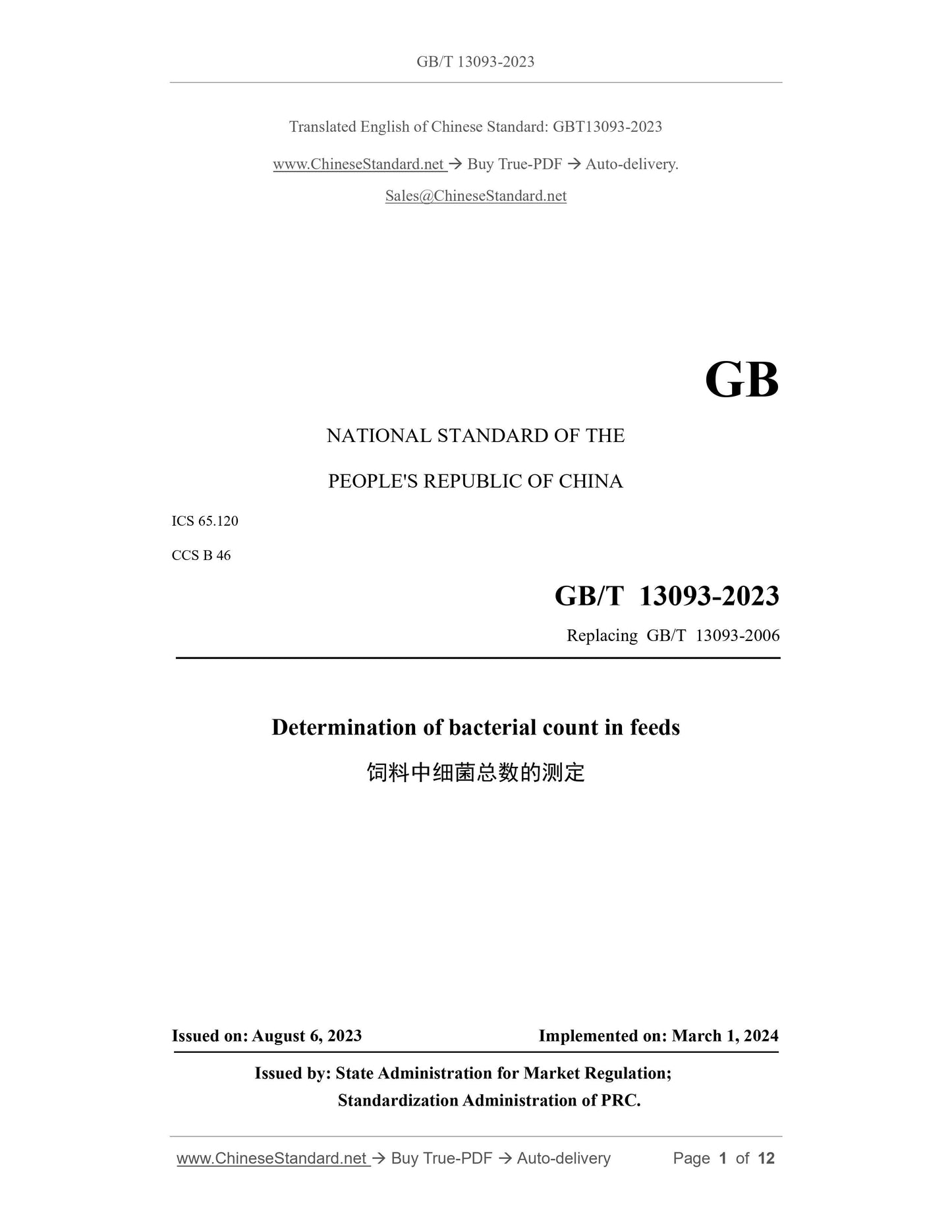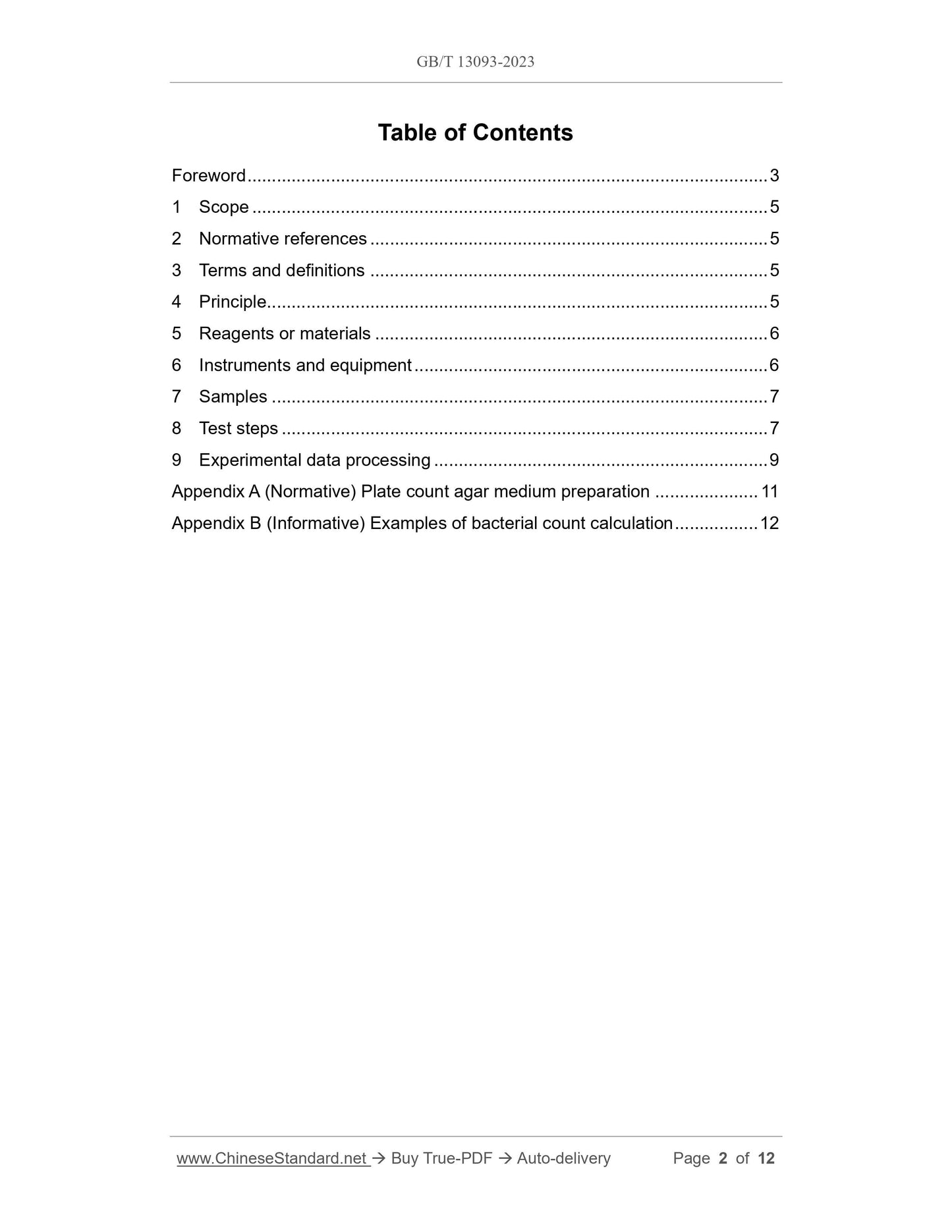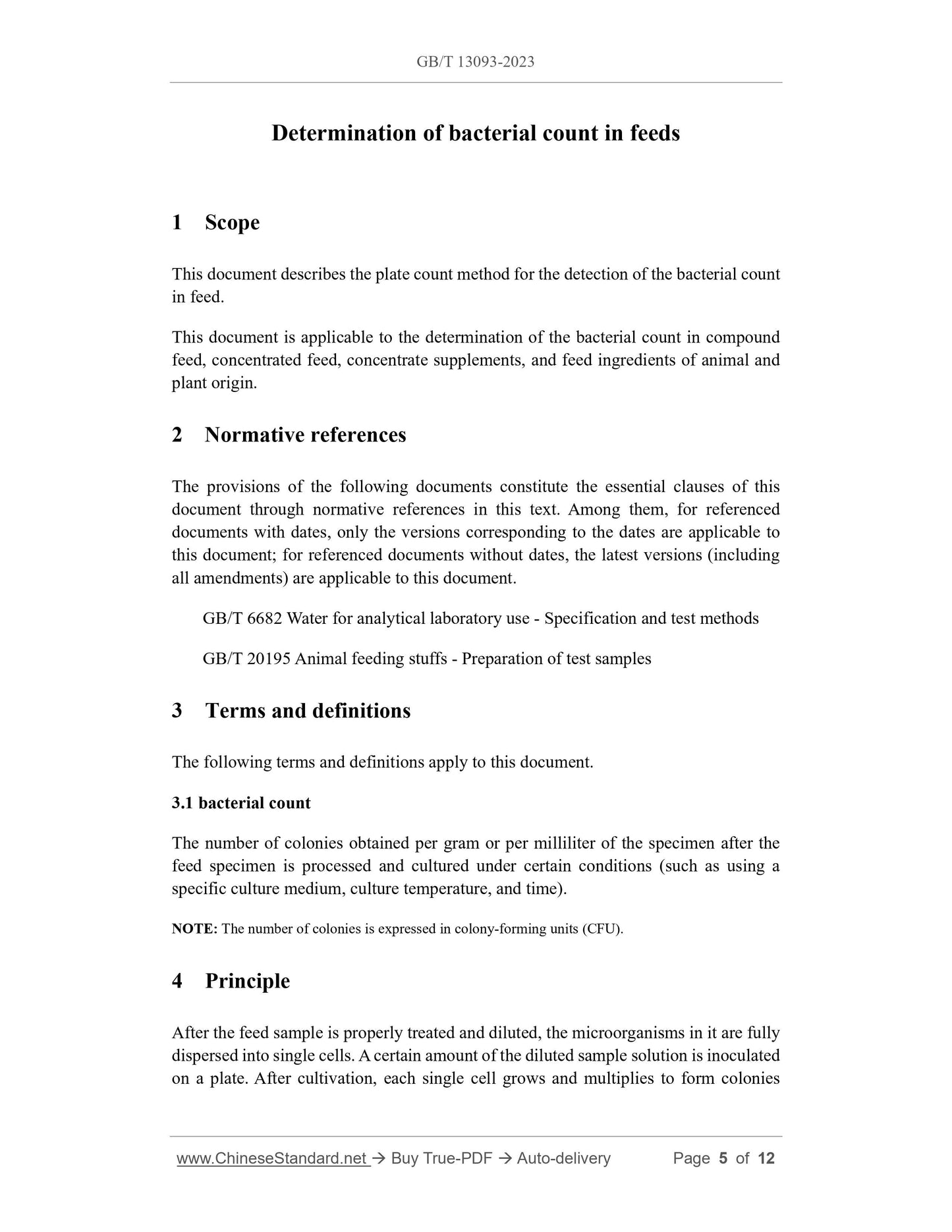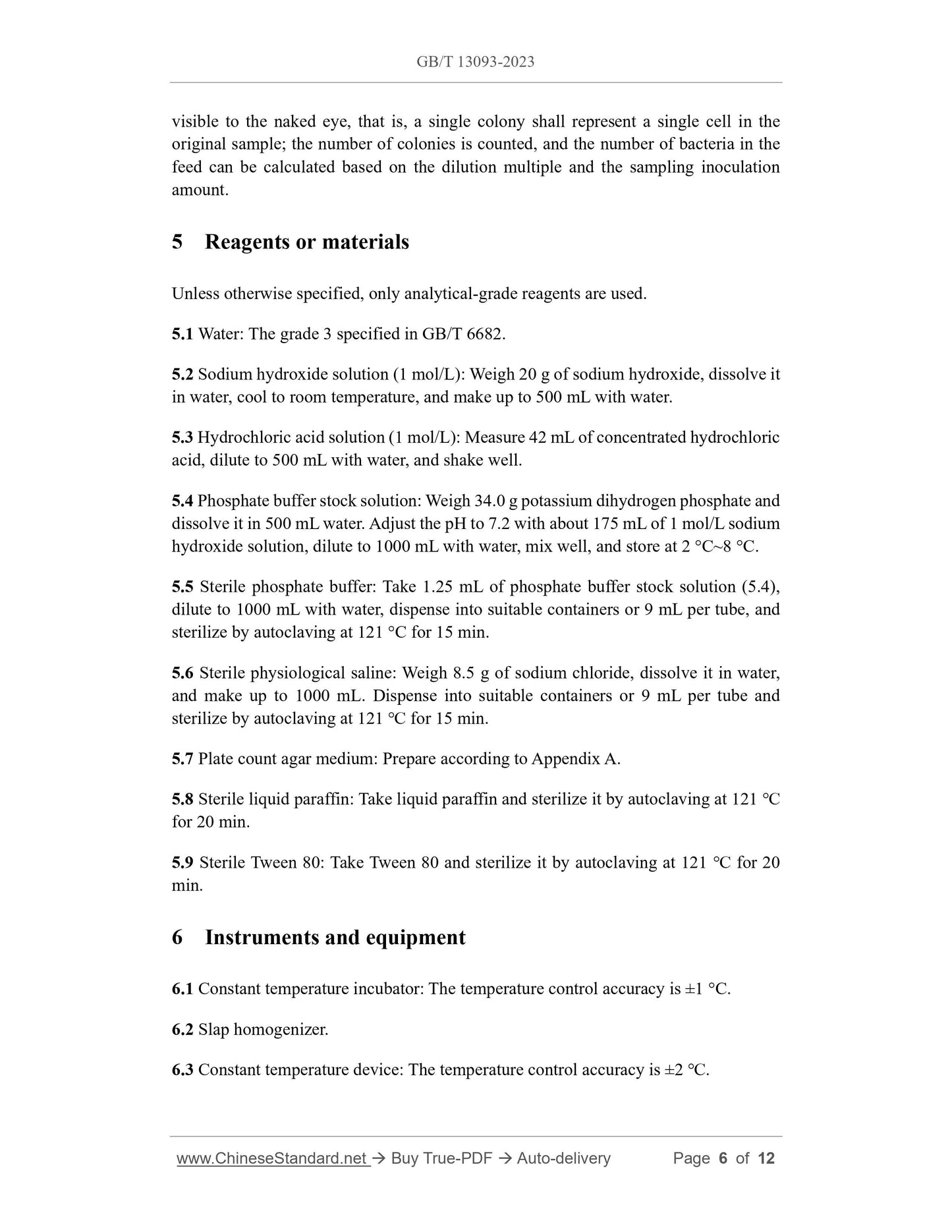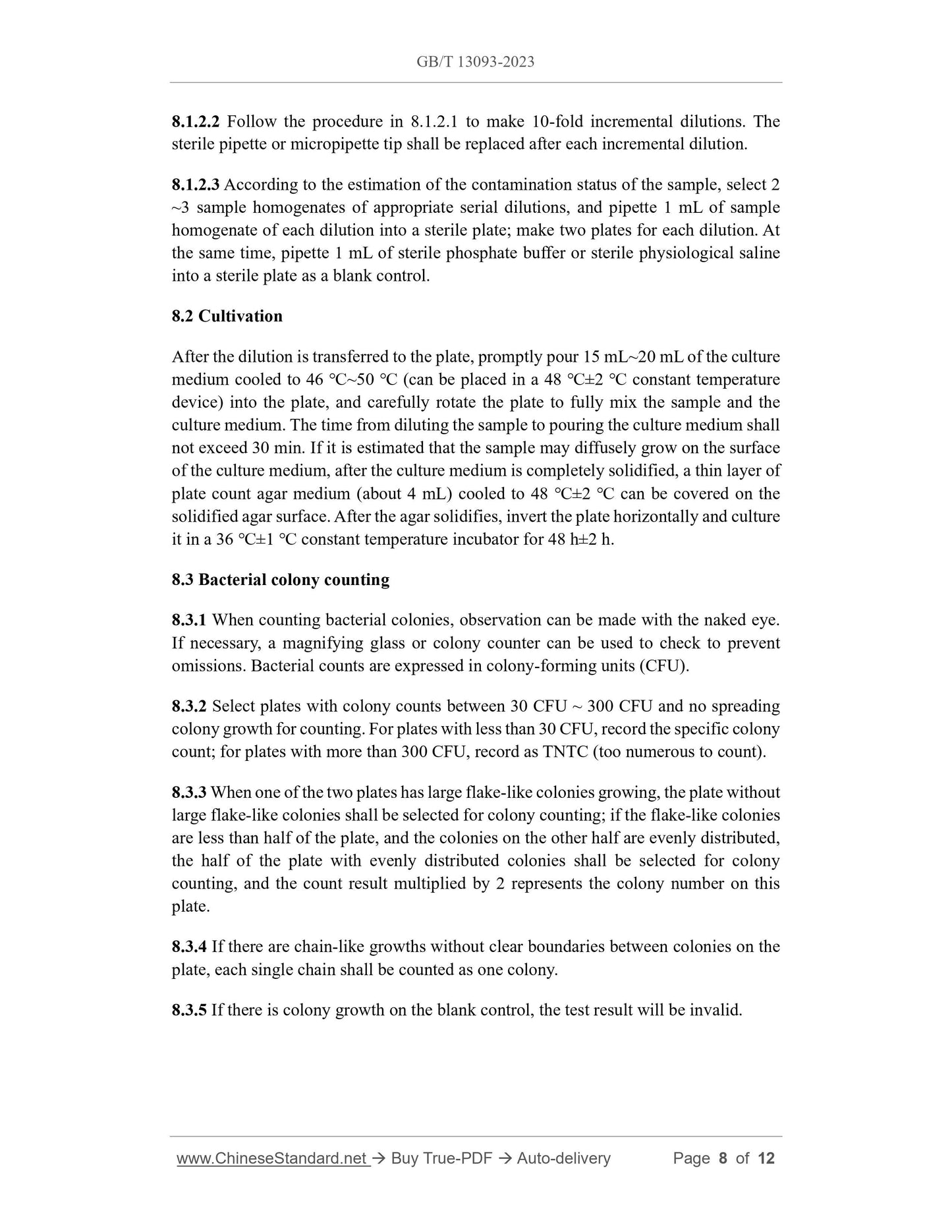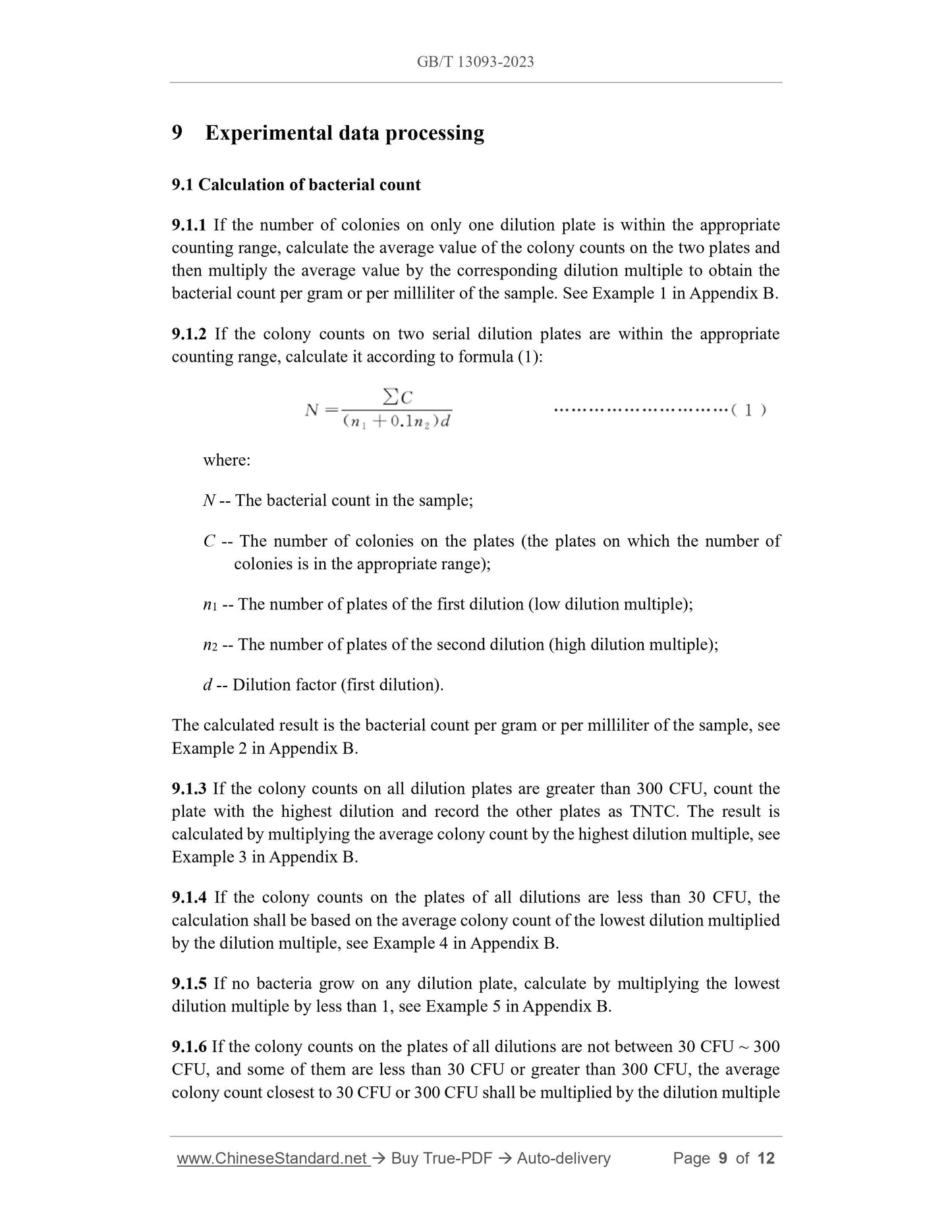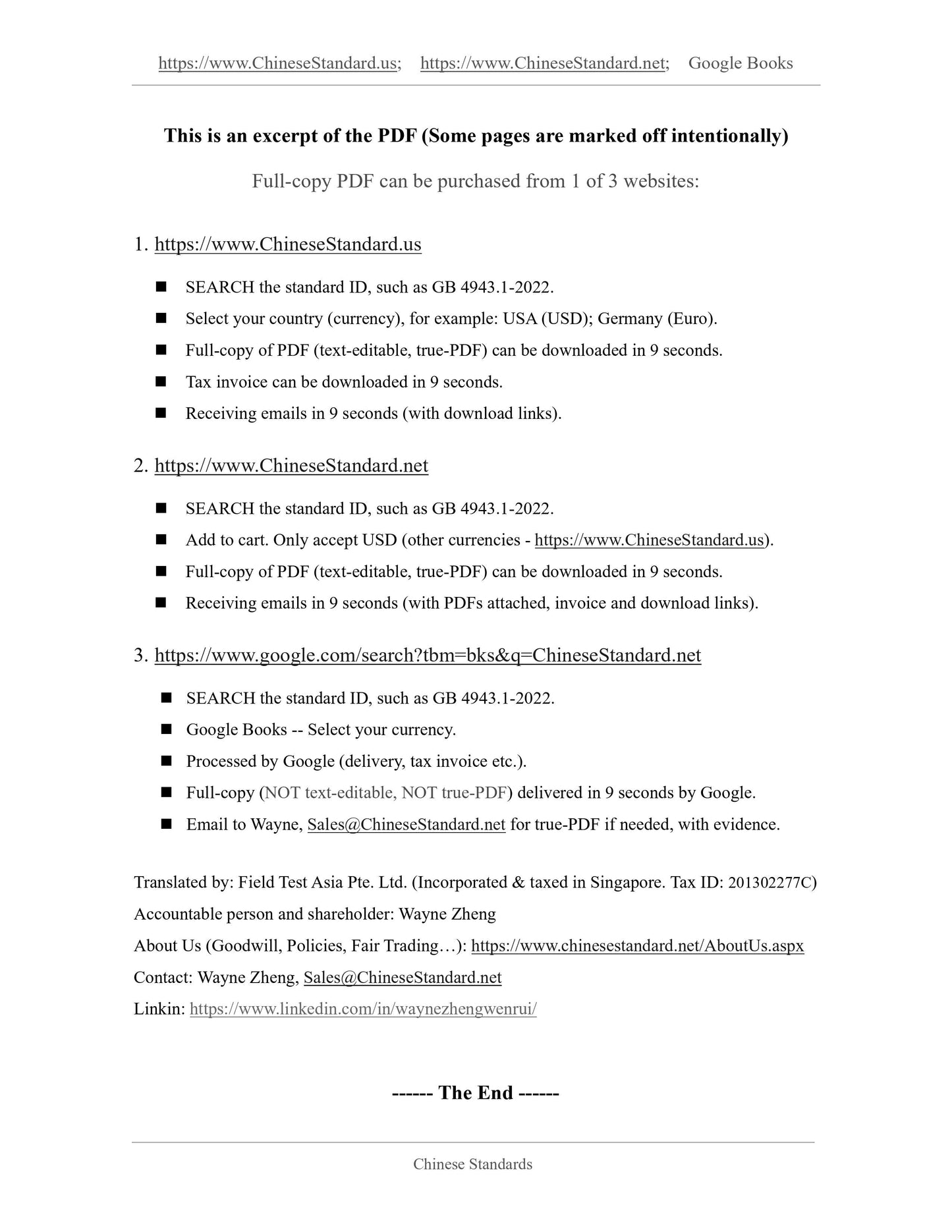1
/
of
7
www.ChineseStandard.us -- Field Test Asia Pte. Ltd.
GB/T 13093-2023 English PDF (GB/T13093-2023)
GB/T 13093-2023 English PDF (GB/T13093-2023)
Regular price
$155.00
Regular price
Sale price
$155.00
Unit price
/
per
Shipping calculated at checkout.
Couldn't load pickup availability
GB/T 13093-2023: Determination of bacterial count in feeds
Delivery: 9 seconds. Download (& Email) true-PDF + Invoice.
Get Quotation: Click GB/T 13093-2023 (Self-service in 1-minute)
Historical versions (Master-website): GB/T 13093-2023
Preview True-PDF (Reload/Scroll-down if blank)
GB/T 13093-2023
GB
NATIONAL STANDARD OF THE
PEOPLE'S REPUBLIC OF CHINA
ICS 65.120
CCS B 46
Replacing GB/T 13093-2006
Determination of bacterial count in feeds
ISSUED ON: AUGUST 6, 2023
IMPLEMENTED ON: MARCH 1, 2024
Issued by: State Administration for Market Regulation;
Standardization Administration of PRC.
Table of Contents
Foreword ... 3
1 Scope ... 5
2 Normative references ... 5
3 Terms and definitions ... 5
4 Principle... 5
5 Reagents or materials ... 6
6 Instruments and equipment ... 6
7 Samples ... 7
8 Test steps ... 7
9 Experimental data processing ... 9
Appendix A (Normative) Plate count agar medium preparation ... 11
Appendix B (Informative) Examples of bacterial count calculation ... 12
Determination of bacterial count in feeds
1 Scope
This document describes the plate count method for the detection of the bacterial count
in feed.
This document is applicable to the determination of the bacterial count in compound
feed, concentrated feed, concentrate supplements, and feed ingredients of animal and
plant origin.
2 Normative references
The provisions of the following documents constitute the essential clauses of this
document through normative references in this text. Among them, for referenced
documents with dates, only the versions corresponding to the dates are applicable to
this document; for referenced documents without dates, the latest versions (including
all amendments) are applicable to this document.
GB/T 6682 Water for analytical laboratory use - Specification and test methods
GB/T 20195 Animal feeding stuffs - Preparation of test samples
3 Terms and definitions
The following terms and definitions apply to this document.
3.1 bacterial count
The number of colonies obtained per gram or per milliliter of the specimen after the
feed specimen is processed and cultured under certain conditions (such as using a
specific culture medium, culture temperature, and time).
NOTE: The number of colonies is expressed in colony-forming units (CFU).
4 Principle
After the feed sample is properly treated and diluted, the microorganisms in it are fully
dispersed into single cells. A certain amount of the diluted sample solution is inoculated
on a plate. After cultivation, each single cell grows and multiplies to form colonies
visible to the naked eye, that is, a single colony shall represent a single cell in the
original sample; the number of colonies is counted, and the number of bacteria in the
feed can be calculated based on the dilution multiple and the sampling inoculation
amount.
5 Reagents or materials
Unless otherwise specified, only analytical-grade reagents are used.
5.1 Water: The grade 3 specified in GB/T 6682.
5.2 Sodium hydroxide solution (1 mol/L): Weigh 20 g of sodium hydroxide, dissolve it
in water, cool to room temperature, and make up to 500 mL with water.
5.3 Hydrochloric acid solution (1 mol/L): Measure 42 mL of concentrated hydrochloric
acid, dilute to 500 mL with water, and shake well.
5.4 Phosphate buffer stock solution: Weigh 34.0 g potassium dihydrogen phosphate and
dissolve it in 500 mL water. Adjust the pH to 7.2 with about 175 mL of 1 mol/L sodium
hydroxide solution, dilute to 1000 mL with water, mix well, and store at 2 °C~8 °C.
5.5 Sterile phosphate buffer: Take 1.25 mL of phosphate buffer stock solution (5.4),
dilute to 1000 mL with water, dispense into suitable containers or 9 mL per tube, and
sterilize by autoclaving at 121 °C for 15 min.
5.6 Sterile physiological saline: Weigh 8.5 g of sodium chloride, dissolve it in water,
and make up to 1000 mL. Dispense into suitable containers or 9 mL per tube and
sterilize by autoclaving at 121 ℃ for 15 min.
5.7 Plate count agar medium: Prepare according to Appendix A.
5.8 Sterile liquid paraffin: Take liquid paraffin and sterilize it by autoclaving at 121 ℃
for 20 min.
5.9 Sterile Tween 80: Take Tween 80 and sterilize it by autoclaving at 121 ℃ for 20
min.
6 Instruments and equipment
6.1 Constant temperature incubator: The temperature control accuracy is ±1 °C.
6.2 Slap homogenizer.
6.3 Constant temperature device: The temperature control accuracy is ±2 ℃.
8.1.2.2 Follow the procedure in 8.1.2.1 to make 10-fold incremental dilutions. The
sterile pipette or micropipette tip shall be replaced after each incremental dilution.
8.1.2.3 According to the estimation of the contamination status of the sample, select 2
~3 sample homogenates of appropriate serial dilutions, and pipette 1 mL of sample
homogenate of each dilution into a sterile plate; make two plates for each dilution. At
the same time, pipette 1 mL of sterile phosphate buffer or sterile physiological saline
into a sterile plate as a blank control.
8.2 Cultivation
After the dilution is transferred to the plate, promptly pour 15 mL~20 mL of the culture
medium cooled to 46 ℃~50 ℃ (can be placed in a 48 ℃±2 ℃ constant temperature
device) into the plate, and carefully rotate the plate to fully mix the sample and the
culture medium. The time from diluting the sample to pouring the culture medium shall
not exceed 30 min. If it is estimated that the sample may diffusely grow on the surface
of the culture medium, after the culture medium is completely solidified, a thin layer of
plate count agar medium (about 4 mL) cooled to 48 ℃±2 ℃ can be covered on the
solidified agar surface. After the agar solidifies, invert the plate horizontally and culture
it in a 36 ℃±1 ℃ constant temperature incubator for 48 h±2 h.
8.3 Bacterial colony counting
8.3.1 When counting bacterial colonies, observation can be made with the naked eye.
If necessary, a magnifying glass or colony counter can be used to check to prevent
omissions. Bacterial counts are expressed in colony-forming units (CFU).
8.3.2 Select plates with colony counts between 30 CFU ~ 300 CFU and no spreading
colony growth for counting. For plates with less than 30 CFU, record the specific colony
count; for plates with more than 300 CFU, record as TNTC (too numerous to count).
8.3.3 When one of the two plates has large flake-like colonies growing, the plate without
large flake-like colonies shall be selected for colony counting; if the flake-like colonies
are less than half of the plate, and the colonies on the other half are evenly distributed,
the half of the plate with evenly distributed colonies shall be selected for colony
counting, and the count result multiplied by 2 represents the colony number on this
plate.
8.3.4 If there are chain-like growths without clear boundaries between colonies on the
plate, each single chain shall be counted as one colony.
8.3.5 If there is colony growth on the blank control, the test result will be invalid.
9 Experimental data processing
9.1 Calculation of bacterial count
9.1.1 If the number of colonies on only one dilution plate is within the appropriate
counting range, calculate the average value of the colony counts on the two plates and
then multiply the average value by the corresponding dilution multiple to obtain the
bacterial count per gram or per milliliter of the sample. See Example 1 in Appendix B.
9.1.2 If the colony counts on two serial dilution plates are within the appropriate
counting range, calculate it according to formula (1):
where:
N -- The bacterial count in the sample;
C -- The number of colonies on the plates (the plates on which the number of
colonies is in the appropriate range);
n1 -- The number of plates of the first dilution (low dilution multiple);
n2 -- The number of plates of the second dilution (high dilution multiple);
d -- Dilution factor (first dilution).
The calculated result is the bacterial count per gram or per milliliter of the sample, see
Example 2 in Appendix B.
9.1.3 If the colony counts on all dilution plates are greater than 300 CFU, count the
plate with the highest dilution and record the other plates as TNTC. The result is
calculated by multiplying the average colony count by the highest dilution multiple, see
Example 3 in Appendix B.
9.1.4 If the colony counts on the plates of all dilutions are less than 30 CFU, the
calculation shall be based on the average colony count of the lowest dilution multiplied
by the dilution multiple, see Example 4 in Appendix B.
9.1.5 If no bacteria grow on any dilution plate, calculate by multiplying the lowest
dilution multiple by less than 1, see Example 5 in Appendix B.
9.1.6 If the colony counts on the plates of all dilutions are not between 30 CFU ~ 300
CFU, and some of them are less than 30 CFU or greater than 300 CFU, the average
colony count closest to 30 CFU or 300 CFU shall be multiplied by the dilution multiple
GB/T 13093-2023
GB
NATIONAL STANDARD OF THE
PEOPLE'S REPUBLIC OF CHINA
ICS 65.120
CCS B 46
Replacing GB/T 13093-2006
Determination of bacterial count in feeds
ISSUED ON: AUGUST 6, 2023
IMPLEMENTED ON: MARCH 1, 2024
Issued by: State Administration for Market Regulation;
Standardization Administration of PRC.
Table of Contents
Foreword ... 3
1 Scope ... 5
2 Normative references ... 5
3 Terms and definitions ... 5
4 Principle... 5
5 Reagents or materials ... 6
6 Instruments and equipment ... 6
7 Samples ... 7
8 Test steps ... 7
9 Experimental data processing ... 9
Appendix A (Normative) Plate count agar medium preparation ... 11
Appendix B (Informative) Examples of bacterial count calculation ... 12
Determination of bacterial count in feeds
1 Scope
This document describes the plate count method for the detection of the bacterial count
in feed.
This document is applicable to the determination of the bacterial count in compound
feed, concentrated feed, concentrate supplements, and feed ingredients of animal and
plant origin.
2 Normative references
The provisions of the following documents constitute the essential clauses of this
document through normative references in this text. Among them, for referenced
documents with dates, only the versions corresponding to the dates are applicable to
this document; for referenced documents without dates, the latest versions (including
all amendments) are applicable to this document.
GB/T 6682 Water for analytical laboratory use - Specification and test methods
GB/T 20195 Animal feeding stuffs - Preparation of test samples
3 Terms and definitions
The following terms and definitions apply to this document.
3.1 bacterial count
The number of colonies obtained per gram or per milliliter of the specimen after the
feed specimen is processed and cultured under certain conditions (such as using a
specific culture medium, culture temperature, and time).
NOTE: The number of colonies is expressed in colony-forming units (CFU).
4 Principle
After the feed sample is properly treated and diluted, the microorganisms in it are fully
dispersed into single cells. A certain amount of the diluted sample solution is inoculated
on a plate. After cultivation, each single cell grows and multiplies to form colonies
visible to the naked eye, that is, a single colony shall represent a single cell in the
original sample; the number of colonies is counted, and the number of bacteria in the
feed can be calculated based on the dilution multiple and the sampling inoculation
amount.
5 Reagents or materials
Unless otherwise specified, only analytical-grade reagents are used.
5.1 Water: The grade 3 specified in GB/T 6682.
5.2 Sodium hydroxide solution (1 mol/L): Weigh 20 g of sodium hydroxide, dissolve it
in water, cool to room temperature, and make up to 500 mL with water.
5.3 Hydrochloric acid solution (1 mol/L): Measure 42 mL of concentrated hydrochloric
acid, dilute to 500 mL with water, and shake well.
5.4 Phosphate buffer stock solution: Weigh 34.0 g potassium dihydrogen phosphate and
dissolve it in 500 mL water. Adjust the pH to 7.2 with about 175 mL of 1 mol/L sodium
hydroxide solution, dilute to 1000 mL with water, mix well, and store at 2 °C~8 °C.
5.5 Sterile phosphate buffer: Take 1.25 mL of phosphate buffer stock solution (5.4),
dilute to 1000 mL with water, dispense into suitable containers or 9 mL per tube, and
sterilize by autoclaving at 121 °C for 15 min.
5.6 Sterile physiological saline: Weigh 8.5 g of sodium chloride, dissolve it in water,
and make up to 1000 mL. Dispense into suitable containers or 9 mL per tube and
sterilize by autoclaving at 121 ℃ for 15 min.
5.7 Plate count agar medium: Prepare according to Appendix A.
5.8 Sterile liquid paraffin: Take liquid paraffin and sterilize it by autoclaving at 121 ℃
for 20 min.
5.9 Sterile Tween 80: Take Tween 80 and sterilize it by autoclaving at 121 ℃ for 20
min.
6 Instruments and equipment
6.1 Constant temperature incubator: The temperature control accuracy is ±1 °C.
6.2 Slap homogenizer.
6.3 Constant temperature device: The temperature control accuracy is ±2 ℃.
8.1.2.2 Follow the procedure in 8.1.2.1 to make 10-fold incremental dilutions. The
sterile pipette or micropipette tip shall be replaced after each incremental dilution.
8.1.2.3 According to the estimation of the contamination status of the sample, select 2
~3 sample homogenates of appropriate serial dilutions, and pipette 1 mL of sample
homogenate of each dilution into a sterile plate; make two plates for each dilution. At
the same time, pipette 1 mL of sterile phosphate buffer or sterile physiological saline
into a sterile plate as a blank control.
8.2 Cultivation
After the dilution is transferred to the plate, promptly pour 15 mL~20 mL of the culture
medium cooled to 46 ℃~50 ℃ (can be placed in a 48 ℃±2 ℃ constant temperature
device) into the plate, and carefully rotate the plate to fully mix the sample and the
culture medium. The time from diluting the sample to pouring the culture medium shall
not exceed 30 min. If it is estimated that the sample may diffusely grow on the surface
of the culture medium, after the culture medium is completely solidified, a thin layer of
plate count agar medium (about 4 mL) cooled to 48 ℃±2 ℃ can be cover...
Delivery: 9 seconds. Download (& Email) true-PDF + Invoice.
Get Quotation: Click GB/T 13093-2023 (Self-service in 1-minute)
Historical versions (Master-website): GB/T 13093-2023
Preview True-PDF (Reload/Scroll-down if blank)
GB/T 13093-2023
GB
NATIONAL STANDARD OF THE
PEOPLE'S REPUBLIC OF CHINA
ICS 65.120
CCS B 46
Replacing GB/T 13093-2006
Determination of bacterial count in feeds
ISSUED ON: AUGUST 6, 2023
IMPLEMENTED ON: MARCH 1, 2024
Issued by: State Administration for Market Regulation;
Standardization Administration of PRC.
Table of Contents
Foreword ... 3
1 Scope ... 5
2 Normative references ... 5
3 Terms and definitions ... 5
4 Principle... 5
5 Reagents or materials ... 6
6 Instruments and equipment ... 6
7 Samples ... 7
8 Test steps ... 7
9 Experimental data processing ... 9
Appendix A (Normative) Plate count agar medium preparation ... 11
Appendix B (Informative) Examples of bacterial count calculation ... 12
Determination of bacterial count in feeds
1 Scope
This document describes the plate count method for the detection of the bacterial count
in feed.
This document is applicable to the determination of the bacterial count in compound
feed, concentrated feed, concentrate supplements, and feed ingredients of animal and
plant origin.
2 Normative references
The provisions of the following documents constitute the essential clauses of this
document through normative references in this text. Among them, for referenced
documents with dates, only the versions corresponding to the dates are applicable to
this document; for referenced documents without dates, the latest versions (including
all amendments) are applicable to this document.
GB/T 6682 Water for analytical laboratory use - Specification and test methods
GB/T 20195 Animal feeding stuffs - Preparation of test samples
3 Terms and definitions
The following terms and definitions apply to this document.
3.1 bacterial count
The number of colonies obtained per gram or per milliliter of the specimen after the
feed specimen is processed and cultured under certain conditions (such as using a
specific culture medium, culture temperature, and time).
NOTE: The number of colonies is expressed in colony-forming units (CFU).
4 Principle
After the feed sample is properly treated and diluted, the microorganisms in it are fully
dispersed into single cells. A certain amount of the diluted sample solution is inoculated
on a plate. After cultivation, each single cell grows and multiplies to form colonies
visible to the naked eye, that is, a single colony shall represent a single cell in the
original sample; the number of colonies is counted, and the number of bacteria in the
feed can be calculated based on the dilution multiple and the sampling inoculation
amount.
5 Reagents or materials
Unless otherwise specified, only analytical-grade reagents are used.
5.1 Water: The grade 3 specified in GB/T 6682.
5.2 Sodium hydroxide solution (1 mol/L): Weigh 20 g of sodium hydroxide, dissolve it
in water, cool to room temperature, and make up to 500 mL with water.
5.3 Hydrochloric acid solution (1 mol/L): Measure 42 mL of concentrated hydrochloric
acid, dilute to 500 mL with water, and shake well.
5.4 Phosphate buffer stock solution: Weigh 34.0 g potassium dihydrogen phosphate and
dissolve it in 500 mL water. Adjust the pH to 7.2 with about 175 mL of 1 mol/L sodium
hydroxide solution, dilute to 1000 mL with water, mix well, and store at 2 °C~8 °C.
5.5 Sterile phosphate buffer: Take 1.25 mL of phosphate buffer stock solution (5.4),
dilute to 1000 mL with water, dispense into suitable containers or 9 mL per tube, and
sterilize by autoclaving at 121 °C for 15 min.
5.6 Sterile physiological saline: Weigh 8.5 g of sodium chloride, dissolve it in water,
and make up to 1000 mL. Dispense into suitable containers or 9 mL per tube and
sterilize by autoclaving at 121 ℃ for 15 min.
5.7 Plate count agar medium: Prepare according to Appendix A.
5.8 Sterile liquid paraffin: Take liquid paraffin and sterilize it by autoclaving at 121 ℃
for 20 min.
5.9 Sterile Tween 80: Take Tween 80 and sterilize it by autoclaving at 121 ℃ for 20
min.
6 Instruments and equipment
6.1 Constant temperature incubator: The temperature control accuracy is ±1 °C.
6.2 Slap homogenizer.
6.3 Constant temperature device: The temperature control accuracy is ±2 ℃.
8.1.2.2 Follow the procedure in 8.1.2.1 to make 10-fold incremental dilutions. The
sterile pipette or micropipette tip shall be replaced after each incremental dilution.
8.1.2.3 According to the estimation of the contamination status of the sample, select 2
~3 sample homogenates of appropriate serial dilutions, and pipette 1 mL of sample
homogenate of each dilution into a sterile plate; make two plates for each dilution. At
the same time, pipette 1 mL of sterile phosphate buffer or sterile physiological saline
into a sterile plate as a blank control.
8.2 Cultivation
After the dilution is transferred to the plate, promptly pour 15 mL~20 mL of the culture
medium cooled to 46 ℃~50 ℃ (can be placed in a 48 ℃±2 ℃ constant temperature
device) into the plate, and carefully rotate the plate to fully mix the sample and the
culture medium. The time from diluting the sample to pouring the culture medium shall
not exceed 30 min. If it is estimated that the sample may diffusely grow on the surface
of the culture medium, after the culture medium is completely solidified, a thin layer of
plate count agar medium (about 4 mL) cooled to 48 ℃±2 ℃ can be covered on the
solidified agar surface. After the agar solidifies, invert the plate horizontally and culture
it in a 36 ℃±1 ℃ constant temperature incubator for 48 h±2 h.
8.3 Bacterial colony counting
8.3.1 When counting bacterial colonies, observation can be made with the naked eye.
If necessary, a magnifying glass or colony counter can be used to check to prevent
omissions. Bacterial counts are expressed in colony-forming units (CFU).
8.3.2 Select plates with colony counts between 30 CFU ~ 300 CFU and no spreading
colony growth for counting. For plates with less than 30 CFU, record the specific colony
count; for plates with more than 300 CFU, record as TNTC (too numerous to count).
8.3.3 When one of the two plates has large flake-like colonies growing, the plate without
large flake-like colonies shall be selected for colony counting; if the flake-like colonies
are less than half of the plate, and the colonies on the other half are evenly distributed,
the half of the plate with evenly distributed colonies shall be selected for colony
counting, and the count result multiplied by 2 represents the colony number on this
plate.
8.3.4 If there are chain-like growths without clear boundaries between colonies on the
plate, each single chain shall be counted as one colony.
8.3.5 If there is colony growth on the blank control, the test result will be invalid.
9 Experimental data processing
9.1 Calculation of bacterial count
9.1.1 If the number of colonies on only one dilution plate is within the appropriate
counting range, calculate the average value of the colony counts on the two plates and
then multiply the average value by the corresponding dilution multiple to obtain the
bacterial count per gram or per milliliter of the sample. See Example 1 in Appendix B.
9.1.2 If the colony counts on two serial dilution plates are within the appropriate
counting range, calculate it according to formula (1):
where:
N -- The bacterial count in the sample;
C -- The number of colonies on the plates (the plates on which the number of
colonies is in the appropriate range);
n1 -- The number of plates of the first dilution (low dilution multiple);
n2 -- The number of plates of the second dilution (high dilution multiple);
d -- Dilution factor (first dilution).
The calculated result is the bacterial count per gram or per milliliter of the sample, see
Example 2 in Appendix B.
9.1.3 If the colony counts on all dilution plates are greater than 300 CFU, count the
plate with the highest dilution and record the other plates as TNTC. The result is
calculated by multiplying the average colony count by the highest dilution multiple, see
Example 3 in Appendix B.
9.1.4 If the colony counts on the plates of all dilutions are less than 30 CFU, the
calculation shall be based on the average colony count of the lowest dilution multiplied
by the dilution multiple, see Example 4 in Appendix B.
9.1.5 If no bacteria grow on any dilution plate, calculate by multiplying the lowest
dilution multiple by less than 1, see Example 5 in Appendix B.
9.1.6 If the colony counts on the plates of all dilutions are not between 30 CFU ~ 300
CFU, and some of them are less than 30 CFU or greater than 300 CFU, the average
colony count closest to 30 CFU or 300 CFU shall be multiplied by the dilution multiple
GB/T 13093-2023
GB
NATIONAL STANDARD OF THE
PEOPLE'S REPUBLIC OF CHINA
ICS 65.120
CCS B 46
Replacing GB/T 13093-2006
Determination of bacterial count in feeds
ISSUED ON: AUGUST 6, 2023
IMPLEMENTED ON: MARCH 1, 2024
Issued by: State Administration for Market Regulation;
Standardization Administration of PRC.
Table of Contents
Foreword ... 3
1 Scope ... 5
2 Normative references ... 5
3 Terms and definitions ... 5
4 Principle... 5
5 Reagents or materials ... 6
6 Instruments and equipment ... 6
7 Samples ... 7
8 Test steps ... 7
9 Experimental data processing ... 9
Appendix A (Normative) Plate count agar medium preparation ... 11
Appendix B (Informative) Examples of bacterial count calculation ... 12
Determination of bacterial count in feeds
1 Scope
This document describes the plate count method for the detection of the bacterial count
in feed.
This document is applicable to the determination of the bacterial count in compound
feed, concentrated feed, concentrate supplements, and feed ingredients of animal and
plant origin.
2 Normative references
The provisions of the following documents constitute the essential clauses of this
document through normative references in this text. Among them, for referenced
documents with dates, only the versions corresponding to the dates are applicable to
this document; for referenced documents without dates, the latest versions (including
all amendments) are applicable to this document.
GB/T 6682 Water for analytical laboratory use - Specification and test methods
GB/T 20195 Animal feeding stuffs - Preparation of test samples
3 Terms and definitions
The following terms and definitions apply to this document.
3.1 bacterial count
The number of colonies obtained per gram or per milliliter of the specimen after the
feed specimen is processed and cultured under certain conditions (such as using a
specific culture medium, culture temperature, and time).
NOTE: The number of colonies is expressed in colony-forming units (CFU).
4 Principle
After the feed sample is properly treated and diluted, the microorganisms in it are fully
dispersed into single cells. A certain amount of the diluted sample solution is inoculated
on a plate. After cultivation, each single cell grows and multiplies to form colonies
visible to the naked eye, that is, a single colony shall represent a single cell in the
original sample; the number of colonies is counted, and the number of bacteria in the
feed can be calculated based on the dilution multiple and the sampling inoculation
amount.
5 Reagents or materials
Unless otherwise specified, only analytical-grade reagents are used.
5.1 Water: The grade 3 specified in GB/T 6682.
5.2 Sodium hydroxide solution (1 mol/L): Weigh 20 g of sodium hydroxide, dissolve it
in water, cool to room temperature, and make up to 500 mL with water.
5.3 Hydrochloric acid solution (1 mol/L): Measure 42 mL of concentrated hydrochloric
acid, dilute to 500 mL with water, and shake well.
5.4 Phosphate buffer stock solution: Weigh 34.0 g potassium dihydrogen phosphate and
dissolve it in 500 mL water. Adjust the pH to 7.2 with about 175 mL of 1 mol/L sodium
hydroxide solution, dilute to 1000 mL with water, mix well, and store at 2 °C~8 °C.
5.5 Sterile phosphate buffer: Take 1.25 mL of phosphate buffer stock solution (5.4),
dilute to 1000 mL with water, dispense into suitable containers or 9 mL per tube, and
sterilize by autoclaving at 121 °C for 15 min.
5.6 Sterile physiological saline: Weigh 8.5 g of sodium chloride, dissolve it in water,
and make up to 1000 mL. Dispense into suitable containers or 9 mL per tube and
sterilize by autoclaving at 121 ℃ for 15 min.
5.7 Plate count agar medium: Prepare according to Appendix A.
5.8 Sterile liquid paraffin: Take liquid paraffin and sterilize it by autoclaving at 121 ℃
for 20 min.
5.9 Sterile Tween 80: Take Tween 80 and sterilize it by autoclaving at 121 ℃ for 20
min.
6 Instruments and equipment
6.1 Constant temperature incubator: The temperature control accuracy is ±1 °C.
6.2 Slap homogenizer.
6.3 Constant temperature device: The temperature control accuracy is ±2 ℃.
8.1.2.2 Follow the procedure in 8.1.2.1 to make 10-fold incremental dilutions. The
sterile pipette or micropipette tip shall be replaced after each incremental dilution.
8.1.2.3 According to the estimation of the contamination status of the sample, select 2
~3 sample homogenates of appropriate serial dilutions, and pipette 1 mL of sample
homogenate of each dilution into a sterile plate; make two plates for each dilution. At
the same time, pipette 1 mL of sterile phosphate buffer or sterile physiological saline
into a sterile plate as a blank control.
8.2 Cultivation
After the dilution is transferred to the plate, promptly pour 15 mL~20 mL of the culture
medium cooled to 46 ℃~50 ℃ (can be placed in a 48 ℃±2 ℃ constant temperature
device) into the plate, and carefully rotate the plate to fully mix the sample and the
culture medium. The time from diluting the sample to pouring the culture medium shall
not exceed 30 min. If it is estimated that the sample may diffusely grow on the surface
of the culture medium, after the culture medium is completely solidified, a thin layer of
plate count agar medium (about 4 mL) cooled to 48 ℃±2 ℃ can be cover...
Share
